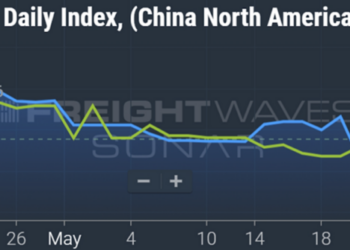The benchmark diesel price used for most fuel surcharges fell again Monday, the eighth decline in the past 10 weeks, while physical markets suggest more declines might be ahead.
The Department of Energy/Energy Information Administration posted a price of $3.987 a gallon for Monday. That was down 10.5 cents from the prior week, the biggest one-week decline in the run of eight weeks of lower prices out of the past 10. The biggest one-week drop had been 9.5 cents a gallon on Oct. 10.
Monday’s decline in the DOE/EIA price came as the futures market for ultra low sulfur diesel on the CME commodity exchange has reversed itself significantly over the past two trading days after seven days of declines.
ULSD settled at $2.5492 a gallon Thursday, dropping almost 35.78 cents from its settlement just over $2.90 on Nov. 28. But ULSD on CME settled Monday at $2.6087 a gallon, rising almost 6 cents in the last two trading days.
Oil in general has been stronger over the past few trading days, but that comes after weeks of declines. It’s difficult to find anybody who thinks the recent increases mark a significant break in sentiment.
More importantly for diesel consumers, physical spreads in the U.S. market are falling rapidly. The spreads are the differential in transactions between buyers and sellers, delivered via pipeline or barge, and represent a discount or premium to the CME price.
The U.S. Gulf Coast market spread for ULSD fell to minus 40 cents a gallon Monday, according to data from DTN. That marked a 6-cent decline just from Friday.
That spread trended lower for all of November and into December. It started November at minus 8 cents a gallon, was down to minus 25 cents by the end of the month and has drifted lower for the first trading days of December before the big falloff Monday.
Similar price movements could be seen in other physical markets. The ULSD spread in Los Angeles was plus 40 cents a gallon as recently as Nov. 16. In five of the past six trading days, DTN estimated the spread was flat between CME ULSD and physical ULSD in Los Angeles.
In New York Harbor, ULSD was 14 cents more than CME on Nov. 30. According to DTN, it was 4 cents a gallon Monday.
Where those weaker differentials show up is in wholesale prices. Broadly speaking, wholesale prices are set on physical prices for the market that supplies the city where the fuel is sold to retail outlets. An Atlanta wholesale price would be set mostly on the basis of what is happening in the Gulf Coast market, because it is the Gulf Coast, shipping diesel primarily along the Colonial or Plantation pipelines, that supplies the Atlanta market.
Even if the price on CME rises significantly, if the physical spread is weakening, that will mute the impact of that CME price in establishing the wholesale price.
When the weaker physical spreads are combined with the fact that time spreads on the ULSD forward curve of prices have narrowed, it leads to the conclusion that diesel inventories and other distillates are starting to build after months of low levels.
The relationship between prices out on the forward curve tightly correlates to inventories. The ULSD market on CME is in backwardation, which means prices for diesel delivery in the future are less than the more current price. In a perfectly balanced market, prices will rise as the market goes out on the calendar. When stocks are tight, they flip into backwardation.
But the backwardation has been narrowing. The spread between spot month and 12-month ULSD hovered near 77 cents a gallon in late October. More recently it has fallen back to about 53 to 54 cents.
Additionally, the weekly EIA inventory report for ULSD has shown inventory builds, rising to 103.7 million barrels for the week ended Dec. 1 from 96.3 million barrels just two weeks earlier.
Diesel markets are getting an early downard push from winter not arriving yet. For example, this forecast of temperatures over the next two weeks shows considerably higher temperatures than normal for December. That was a factor in the Henry Hub natural gas price falling Monday to $2.431 per thousand cubic feet, its lowest level since June.
More articles by John Kingston
The inside story of how GlobalTranz and Worldwide Express came together
Monthly trucking employment report steady after lots of volatility
3PLs get fresh legal win in fight to block liability in truck accidents
The post DOE/EIA diesel price falls again; physical markets sagging also appeared first on FreightWaves.














